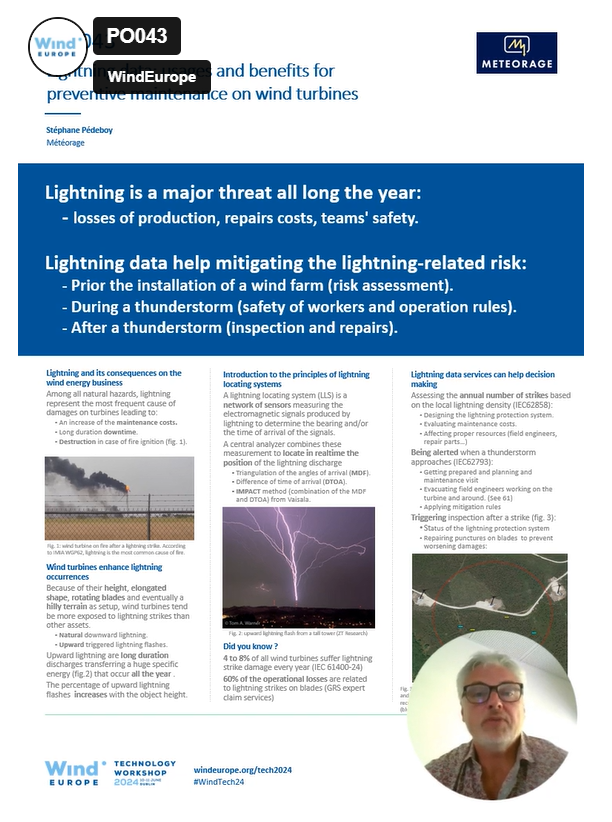Preventive maintenance of wind turbines, uses and benefits of lightning data
This study was presented at the WindEurope Dublin Technology Workshop.

Abstract
Lightning and thunderstorms represent a significant risk to the wind energy industry. Last year in the US, lightning damage cost the wind energy industry more than $100 million and accounted for 60% of blade losses.
The damage – visible and invisible – caused by lightning following a storm is manifold.
It can be material and economic: structural, mechanical, electrical – with the direct destruction or premature ageing of blades, nacelles, masts, lightning protection components – as well as the loss or temporary stoppage of production.
Inspecting wind turbines in the event of a storm is therefore becoming essential for operators, and is recommended by standards such as IEC 62305-3 or IEC 61400-24.
The decision to carry out an inspection can hardly be taken without a system for monitoring storm activity.
Relying on the occurrence of a thunderstorm in a zone, typically 20 km, corresponding approximately to the zone around a wind farm where it may be visible, would be irrelevant and costly, as only one thunderstorm in 5 or even 10 generates lightning on a wind farm. In this case, it makes more sense to install lightning counters on each wind turbine in a wind farm: an expensive choice, however, which probably explains why it has not been systematised, unlike lightning protection systems (LPS) which are installed on each wind turbine.
Using lightning location system (LLS) data is also an alternative way of triggering targeted checks or avoiding them, and does not require any equipment to be installed on each wind turbine. Some LLSs can exceed a cloud-to-ground (CG) detection efficiency of over 97%, with a median location accuracy of 100 metres, making the information usable for deciding whether or not to trigger a check.
However, despite improvements in performance over the last few years, the information does not systematically allow us to determine which turbine has been affected and may require us to check several turbines in the park. In addition, it is sometimes necessary to analyse and interpret the data, as the location of a CG in relation to a turbine is not the only criterion to be taken into account. For example, the intensity of a CG can vary from one turbine to another.
The analysis of 10 recent cases of lightning damage to wind turbines is a first step towards using combined criteria to determine the most appropriate choices. By using both precision measurement criteria represented by an ellipse of uncertainty, the distance and the peak current CG, and also the occurrence of intra-clouds which, in the specific field of turbines, can be the marker of an upward lightning strike, the idea is to improve the diagnosis so as to conclude even more effectively that verification should be triggered.
The results of this study were presented at the WindEurope Technology Workshop in Dublin (2024).
